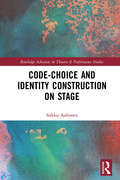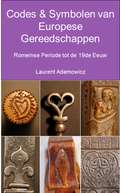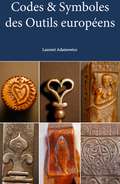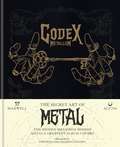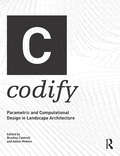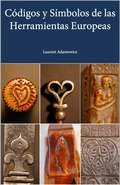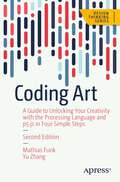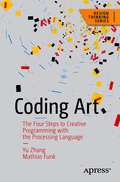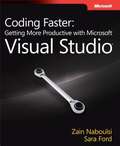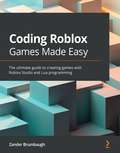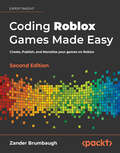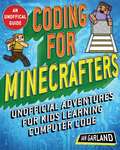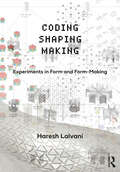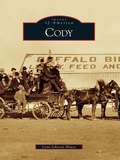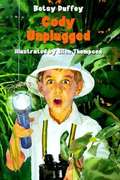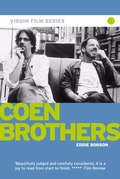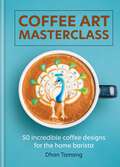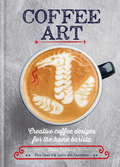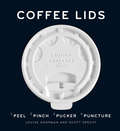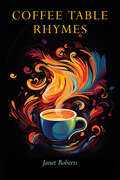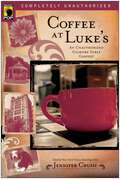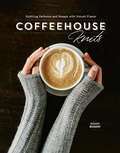- Table View
- List View
Code-Choice and Identity Construction on Stage: Code-choice in Identity Construction on Stage (Routledge Advances in Theatre & Performance Studies)
by Sirkku AaltonenCode-Choice and Identity Construction on Stage challenges the general assumption that language is only one of the codes employed in a theatrical performance; Sirkku Aaltonen changes the perspective to the audience, foregrounding the chosen language variety as a trigger for their reactions. Theatre is ‘the most public of arts’, closely interwoven with contemporary society, and language is a crucial tool for establishing order. In this book, Aaltonen explores the ways in which chosen languages on stage can lead to rejection or tolerance in diglossic situations, where one language is considered unequal to another. Through a selection of carefully chosen case studies, the socio-political rather than artistic motivation behind code-choice emerges. By identifying common features of these contexts and the implications of theatre in the wider world, this book sheds light on high versus low culture, the role of translation, and the significance of traditional and emerging theatrical conventions. This intriguing study encompassing Ireland, Scotland, Quebec, Finland and Egypt, cleverly employs the perspective of familiarising the foreign and is invaluable reading for those interested in theatre and performance, translation, and the connection between language and society.
Codes & Symbolen van Europese Gereedschappen, Romeinse Periode tot 19de Eeuw
by Luc Wyn Laurent AdamowiczHet onvertelde verhaal van mysterieuze codes en symbolen gevonden op antieke gereedschappen van allerlei ambachten Codes en Symbolen van Europese Gereedschappen is het onvertelde verhaal van mysterieuze codes en symbolen gevonden op antieke gereedschappen van allerlei stielen, van de Romeinse periode tot de 19de eeuw. Het omvat 237 kleuren-illustraties van gereedschappen, hun verborgen symbolen en antieke manuscripten. Waarom bevatten zoveel antieke gereedschappen symbolen zoals sterren, kruisen, spiralen en harten? Waarom dragen hamers, regels en beitels stempels die bestaan uit een kompas en een vierkant? Waarom zijn letters, nummers en vreemde tekens zoals het nummer vier met een lange steel en een dubbel kruis gegraveerd in andere gereedschappen? Waarom vertonen zoveel gereedschappen van niet verwante stielen een hart, of precies hetzelfde patroon van een visgraat of zelfs de letters “IHS” of IOS”? In een poging om deze vragen te beantwoorden, moet men terugreizen in de tijd en niet enkel de historische context bestuderen maar ook de mannen en vrouwen die ze maakten met hun handen en hun hart. Deze studie is het verhaal van die mannen en vrouwen die kathedralen en huizen bouwden, bruggen en wegen, monumenten en dromen.
Codes et Symboles des Outils européens
by Kimberley Philippon Laurent AdamowiczL’histoire méconnue des symboles figurant sur les outils de divers métiers anciens enfin décodée. « Outils européens : Codes et Symboles » nous fait découvrir l’histoire qui se cache derrière les symboles qu’on trouve sur de nombreux outils anciens (de l’époque romaine au XIXe siècle). Cet ouvrage compte 237 illustrations en couleur de ces outils et de leurs symboles cachés ainsi que de manuscrits anciens. Pourquoi des étoiles, des croix, des spirales ou encore des cœurs figurent sur tant d’outils anciens ? Pourquoi certaines scies, marteaux, règles et ciseaux comportent une équerre et un compas en guise d’estampe ? Pourquoi d’autres sont gravés de lettres, de nombres et d’étranges symboles, comme le chiffre 4 dont la barre verticale est allongée et croisée de deux traits ? Pourquoi encore peut-on apercevoir des cœurs, des arêtes de poisson et même les lettres « IHS » ou « IOS » sur tant d’outils issus de métiers si divers ? Pour répondre à ces questions, il faut remonter le temps et s’intéresser non seulement au contexte dans lequel ces outils ont été conçus, mais également aux hommes et aux femmes qui les ont fabriqués avec leurs mains et leur cœur. Cet ouvrage raconte l’histoire de ces hommes et femmes qui ont érigé des maisons, des cathédrales, des ponts, des routes, des monuments, mais aussi des rêves.
Codex Metallum: The secret art of metal decoded
by Alt236 Maxwell***Decode the secret language of metal.Metal music has a rich and powerful visual language like no other genre. From death and the devil to mythology and the occult, the artworks of its greatest albums carry a complex hidden code of deeper meanings.Codex Metallum is your unique guide to these visual themes. Featuring the covers of 250 iconic albums from Black Sabbath to Slipknot and Motörhead to Pantera, as well as bespoke illustrations by Rammstein collaborators Førtifem, this one-of-a-kind book decodes the imagery of metal and unlocks the secrets hidden within.Packaged in an embossed, leather-effect case with metallic foil finishes, Codex Metallum is a stunning collector's item and essential reading for any metalhead.
Codex Metallum: The secret art of metal decoded
by Alt236 Maxwell***Decode the secret language of metal.Metal music has a rich and powerful visual language like no other genre. From death and the devil to mythology and the occult, the artworks of its greatest albums carry a complex hidden code of deeper meanings.Codex Metallum is your unique guide to these visual themes. Featuring the covers of 250 iconic albums from Black Sabbath to Slipknot and Motörhead to Pantera, as well as bespoke illustrations by Rammstein collaborators Førtifem, this one-of-a-kind book decodes the imagery of metal and unlocks the secrets hidden within.Packaged in an embossed, leather-effect case with metallic foil finishes, Codex Metallum is a stunning collector's item and essential reading for any metalhead.
Codify: Parametric and Computational Design in Landscape Architecture
by Bradley Cantrell Adam MekiesCodify: Parametric and Computational Design in Landscape Architecture provides a series of essays that explore what it means to use, modify and create computational tools in a contemporary design environment. Landscape architecture has a long history of innovation in the areas of computation and media, particularly in how the discipline represents, analyses, and constructs complex systems. This curated volume spans academic and professional projects to form a snapshot of digital practices that aim to show how computation is a tool that goes beyond methods of representation and media. The book is organized in four sections; syntax, perception, employ, and prospective. The essays are written by leading academics and professionals and the sections examine the role of computational tools in landscape architecture through case studies, historical accounts, theoretical arguments, and nascent propositions.
Codigos y Simbolos de las Herramientas Europeas
by Laurent AdamowiczLa historia jamás contada de los misteriosos códigos y símbolos encontrados en las herramientas antiguas de cualquier oficio Códigos y símbolos de las herramientas europeas es la historia jamás contada de los misteriosos códigos y símbolos encontrados en las herramientas antiguas de cualquier oficio, desde el Imperio Romano hasta el siglo XIX. Comprende 237 ilustraciones de manuscritos antiguos y de herramientas con sus símbolos ocultos. ¿Por qué tantos instrumentos contienen símbolos como estrellas, cruces, espirales y corazones? ¿Por qué las sierras, martillos, reglas y cinceles tienen estampado el compás y la escuadra? ¿Por qué hay otras herramientas grabadas con letras, números, signos extraños como en numeral 4 con un tallo largo y dos que lo cruzan? ¿Por qué tantos utensilios de oficios no relacionados presentan un corazón, o el mismo patrón exacto de una espina de pescado, e incluso las letras “IHS” o “IOS”? Para intentar responder a estas preguntas debemos viajar atrás en el tiempo y estudiar, no solo el contexto histórico en el que fueron fabricados, sino también a los hombres y mujeres que los hicieron con sus propias manos y sus corazones. Este estudio es la historia de esas personas que construyeron catedrales y casas, puentes y carreteras, monumentos y sueños.
Coding Art: A Guide to Unlocking Your Creativity with the Processing Language and p5.js in Four Simple Steps (Design Thinking)
by Yu Zhang Mathias FunkFinally, a book on creative programming, written directly for artists and designers! This second edition offers expanded and updated content incorporating the latest advancements and trends in the field of creative programming, also for creatives who want to work directly with P5.js and online. It delves deeper into the intricacies of computational art. It includes fresh case studies that explore real-world applications of coding art, inspiring readers to think beyond traditional boundaries.Rather than following a computer science curriculum, this book is aimed at creatives who are working in the intersection of design, art, and education. Following a real-world use case of computation art, you'll see how it relates back to the four key pillars, and addresses potential pitfalls and challenges in the creative process. All code examples are presented in a fully integrated Processing example library, making it easy for readers to get started. This unique and finely balanced approach between skill acquisition and development makes Coding Art, Second Edition the ideal reference book for both creative programming and the creative process for professors and students alike.What You’ll LearnReview ideas and approaches from creative programming to different professional domainsWork with computational tools like the Processing languageUnderstand the skills needed to move from static elements to animation to interactionUse interactivity as input to bring creative concepts closer to refinement and depthSimplify and extend the design of aesthetics, rhythms, and smoothness with data structuresLeverage the diversity of art code on other platforms like the web or mobile applicationsUnderstand the end-to-end process of computation art through real world use casesStudy best practices, common pitfalls, and challenges of the creative processWho This Book Is ForThose looking to see what computation and data can do for their creative expression; learners who want to integrate computation and data into their practices in different perspectives; creative technologists, educators, digital artists and those who already know how to program, seeking creativity and inspiration in the context of computation and data.
Coding Art: The Four Steps to Creative Programming with the Processing Language (Design Thinking)
by Yu Zhang Mathias FunkFinally, a book on creative programming, written directly for artists and designers! Rather than following a computer science curriculum, this book is aimed at creatives who are working in the intersection of design, art, and education. In this book you'll learn to apply computation into the creative process by following a four-step process, and through this, land in the cross section of coding and art, with a focus on practical examples and relevant work structures. You'll follow a real-world use case of computation art and see how it relates back to the four key pillars, and addresses potential pitfalls and challenges in the creative process. All code examples are presented in a fully integrated Processing example library, making it easy for readers to get started.This unique and finely balanced approach between skill acquisition and the creative process and development makes Coding Art a functional reference book for both creative programming and the creative process for professors and students alike.What You’ll LearnReview ideas and approaches from creative programming to different professional domainsWork with computational tools like the Processing languageUnderstand the skills needed to move from static elements to animation to interactionUse interactivity as input to bring creative concepts closer to refinement and depthSimplify and extend the design of aesthetics, rhythms, and smoothness with data structuresLeverage the diversity of art code on other platforms like the web or mobile applicationsUnderstand the end-to-end process of computation art through real world use casesStudy best practices, common pitfalls, and challenges of the creative processWho This Book Is ForThose looking to see what computation and data can do for their creative expression; learners who want to integrate computation and data into their practices in different perspectives; and those who already know how to program, seeking creativity and inspiration in the context of computation and data.
Coding Faster: Getting More Productive with Microsoft® Visual Studio®
by Sara Ford Zain NaboulsiExpert advice to help you work smarter and increase your productivity with Visual Studio. Take a detailed look into Visual Studio--and learn practical techniques to help you work more efficiently. This fully revised and expanded version of Visual Studio Tips: 251 Ways to Improve Your Productivity includes a comprehensive collection of tips and shortcuts for working with the code editor, visual designers, searches, debugger, and other features in Visual Studio 2005, 2008, and 2010. You'll gain valuable insights for using this IDE--no matter what your experience level. Discover how to: Change development settings and keyboard mappings to optimize your efficiency Save time initiating a new project by creating custom templates Uncover secrets for working with the toolbox, commands, and window layouts Work with files in more practical ways, such as using the File Tab Channel Use the Editor more effectively with tips on selecting and manipulating code Apply techniques to help reduce the time you spend debugging code Create Visual Studio extensions to increase your development productivity
Coding Roblox Games Made Easy: The ultimate guide to creating games with Roblox Studio and Lua programming
by Zander BrumbaughGet up and running with Roblox development with the help of expert guidance for working with Roblox components and Lua programmingKey FeaturesDiscover solutions to common problems faced while creating games on RobloxExplore tips, tricks, and best practices and learn advanced Roblox coding techniques to create gamesUnderstand how to program in the Roblox Lua language, add engaging effects, add a variety of functionalities, and much moreBook DescriptionRoblox is a global virtual platform like no other for both playing and creating games. With well over 150 million monthly active users, Roblox hosts all genres of games that can be played by other members of the community using the Lua programming language. Not only can you create games for free, but you can also earn considerable sums of money if from the success of your games, and become part of the vast and supportive developer circle that provides excellent opportunities for networking in a tight-knit community. With this practical book, you'll get hands-on experience working on the Roblox platform. You'll start with an overview of Roblox development and then understand how to use Roblox Studio. As you progress, you'll gradually learn everything you need from how to program in Roblox Lua to creating Obby and Battle Royale games. Finally, you'll delve into the logistics of game production, focusing on optimizing the performance of your game by implementing impressive mechanics, monetization, and marketing practices. By the end of this Roblox book, you'll be able to lead or work with a team to bring your gaming world to life, and extend that experience to players around the world.What you will learnGet started with Roblox development and explore aspects such as choosing a developer typeUnderstand how to use Roblox Studio and other free resourcesCreate your first game with the Roblox Lua programming languageBecome well-versed with the three Ms - Mechanics, Monetization, and MarketingDevelop real-world games such as Battle Royale and ObbyDiscover expert tips for collaborating effectively and managing project workloadsWho this book is forThis Roblox guide is for anyone interested in learning how to develop games on the Roblox platform. If you're already familiar with Roblox and looking for tips, tricks, and Roblox and Lua best practices for efficient development, you'll find this book helpful.
Coding Roblox Games Made Easy: The ultimate guide to creating games with Roblox Studio and Luau programming, 2nd Edition
by Zander BrumbaughGet up and running with Roblox environment and Luau programming basics to build and share your gamesIncludes an exclusive invite to join the online Roblox game development communityKey FeaturesBegin coding in Luau: build player avatars, battlefields, game physics, countdown timers and moreLearn tips, tricks, best practices, and advanced Roblox coding techniques to create 3D gamesJoin the book club to discuss queries, provide solutions, and ask Zander for advice on your gamesBook DescriptionRoblox is a huge entertainment platform like no other for both playing and creating games. With over 200 million monthly active users, Roblox has enabled new and experienced developers to create successful games, often called experiences, that can be played globally at no cost.Coding Roblox Games Made Easy, 2nd Edition, builds a solid foundation of the concepts you need to embark on the journey of building two end-to-end games in Roblox in increasing order of complexity.For the first game, you will create obstacles and traps for an obstacle course game (obby) and overcome them to win the game alongside other players and earn rewards. In the next game, you will manage player avatars, their weapons, a battlefield and add programming logic for the players to find their weapons and fight, with a reward for the last player standing.Finally, you'll delve into the logistics of game production, focusing on optimizing your games' performance by implementing impressive mechanics, monetization, and marketing practices. We will also discuss how the Metaverse is set to change the dynamics of user experience and what the future holds for Roblox game developers.Let's create and share experiences through play!What you will learnUnderstand how to use Roblox Studio and other free resourcesLearn how to code in Luau: basics, game systems, physics manipulation, etc.Test, evaluate, and redesign to create bug-free and engaging gamesUse Roblox programming and rewards to make your first gameMove from a lobby to a battleground, build avatars and create weapons with which to fightMaster the three Ms: Mechanics, Monetization, MarketingLearn 50 cool things to do on RobloxWho this book is forGet started with building your first game on the Roblox platform. This book is for anyone interested in learning the fundamentals of Luau programming and Roblox Studio and needs direction to build and share games. If you're already familiar with Roblox and are looking for tips, tricks, and the best Roblox and Luau practices for efficient development, you'll find this book helpful.The book requires no prior knowledge of game development.
Coding for Minecrafters: Unofficial Adventures for Kids Learning Computer Code
by Ian GarlandLearn to Code while Adventuring through the Overworld!This fun and educational activity book Introduces kids to the world of coding through the Minecraft world they love. Colorfully illustrated characters and themes from their favorite video game bring the excitement of coding to life, while easy-to-follow screenshots guide them through activities. With adventures that include design, music, animation, gaming, and more, learners will discover tons of ways coding connects to other activities they love and how far a little imagination and invention can take them…to The End and beyond! Minecrafting-themed characters help kids become master coders Kid-friendly concepts and steps designed specifically for ages 8-12 Great games, mods, experiments, and more teach computational thinking—how to tackle large problems by breaking them down into a sequence of smaller, more manageable problems Whether brand-new to coding or looking for more hands-on learning, Coding for Minecrafters helps young coders advance in technology education by leaps and bounds—and have fun doing it!
Coding, Shaping, Making: Experiments in Form and Form-Making
by Haresh LalvaniCoding, Shaping, Making combines inspiration from architecture, mathematics, biology, chemistry, physics and computation to look towards the future of architecture, design and art. It presents ongoing experiments in the search for fundamental principles of form and form-making in nature so that we can better inform our own built environment. In the coming decades, matter will become encoded with shape information so that it shapes itself, as happens in biology. Physical objects, shaped by forces as well, will begin to design themselves based on information encoded in matter they are made of. This knowledge will be scaled and trickled up to architecture. Consequently, architecture will begin to design itself and the role of the architect will need redefining. This heavily illustrated book highlights Haresh Lalvani’s efforts towards this speculative future through experiments in form and form-making, including his work in developing a new approach to shape‐coding, exploring higher‐dimensional geometry for designing physical structures and organizing form in higher-dimensional diagrams. Taking an in-depth look at Lalvani’s pioneering experiments of mass customization in industrial products in architecture, combined with his idea of a form continuum, this book argues for the need for integration of coding, shaping and making in future technologies into one seamless process. Drawing together decades of research, this book will be a thought-provoking read for architecture professionals and students, especially those interested in the future of the discipline as it relates to mathematics, science, technology and art. It will also interest those in the latter fields for its broader implications.
Cody
by Lynn Johnson HouzeFounded in 1896 by William F. "Buffalo Bill" Cody and members of the Shoshone Land and Irrigation Company, Cody lies 53 miles east of Yellowstone National Park. Situated in a geographical area known as the Big Horn Basin, the town is surrounded by part of the front range of the Absaroka Mountains. The Chicago, Burlington, and Quincy Railroad'sarrival in 1901 coincided with Cody's incorporation as a town. The Irma Hotel, named for Buffalo Bill's youngest daughter, opened in 1902 and provided visitors with a modern, luxurious place to stay. In 1909, Cody became the county seat of the newly formed Park County. Cody and the surrounding areas are known for their superb scenery, excellent hunting and fishing, gas and mineral reserves, and vast ranching lands.
Cody Unplugged
by Betsy DuffeyConcerned that his television and video habits have gotten out of hand, Cody's parents send him to Camp Bear where he learns to experience real life rather than virtual reality.
Coen Brothers - Virgin Film (Virgin Film Ser.)
by Eddie RobsonJoel and Ethan Coen make up one of the most original and unconventional movie-making partnerships to come out of America at the end of the 20th century. From their debut tour de force Blood Simple to the hugely acclaimed The Man Who Wasn't There, the brothers' films have attracted critical kudos and commercial success in equal measure due to their irreverent, individual and technically virtuoso nature. Each of their films defies categorisation, yet you're never in any doubt you're watching a Coen brothers movie. This exploration of the movie career of Hollywood's best-loved outsiders charts their rise from cult favourites to box-office contenders, whilst combining indispensable reference material and critical analysis of their films.
Coffee Art Masterclass: 50 incredible coffee designs for the home barista
by Dhan TamangTake your coffee art to the next level with 50 spectacular-yet-simple latte art designs to impress family and friends. From the comfort of your own kitchen you can recreate great paintings, pour and etch stunning natural wonders, iconic buildings and fantastical creatures. No special equipment is needed and once you've mastered the basics a world of incredible coffee art awaits you.Coffee Art Masterclass includes next-level latte designs that everyone can achieve.
Coffee Art Masterclass: 50 incredible coffee designs for the home barista
by Dhan TamangTake your coffee art to the next level with 50 spectacular-yet-simple latte art designs to impress family and friends. From the comfort of your own kitchen you can recreate great paintings, pour and etch stunning natural wonders, iconic buildings and fantastical creatures. No special equipment is needed and once you've mastered the basics a world of incredible coffee art awaits you.Coffee Art Masterclass includes next-level latte designs that everyone can achieve.
Coffee Art: Creative Coffee Designs for the Home Barista
by Dhan TamangOver 128 pages of 60 stunning designs from Britain's champion latte artist. From free pouring to etching, stencilling and more complicated designs for the black belt barista, you'll have fun emulating innovative designs such as The Swan, The Unicorn, and frothy 3-D babyccino animals. The book even includes 9 stencil patterns for you to trace and try.Starting with basic skills and patterns, readers will learn how to create the crema (the froth that acts as a canvas in the coffee cup) and how to produce the hearts, rosettas and tulips that will be used as the basis to form more complicated artworks. Dhan Tamang is a world-renowned latte artist particularly known for his use of colour, and now you too can create impressive multicoloured designs following Dhan's step-by-step instructions. By the end of this book you will be able to create fabulous designs to delight family members and dinner party guests alike.
Coffee Art: Creative Coffee Designs for the Home Barista
by Dhan TamangOver 128 pages of 60 stunning designs from Britain's champion latte artist. From free pouring to etching, stencilling and more complicated designs for the black belt barista, you'll have fun emulating innovative designs such as The Swan, The Unicorn, and frothy 3-D babyccino animals. The book even includes 9 stencil patterns for you to trace and try.Starting with basic skills and patterns, readers will learn how to create the crema (the froth that acts as a canvas in the coffee cup) and how to produce the hearts, rosettas and tulips that will be used as the basis to form more complicated artworks. Dhan Tamang is a world-renowned latte artist particularly known for his use of colour, and now you too can create impressive multicoloured designs following Dhan's step-by-step instructions. By the end of this book you will be able to create fabulous designs to delight family members and dinner party guests alike.
Coffee Lids: Peel, Pinch, Pucker, Puncture
by Louise Harpman Scott Specht Alex KalmanIf you're one of the 200 million Americans who drink coffee every day, you may have marveled at the ubiquitous plastic coffee cup lid, with its clever combination of indentations, protrusions, tabs, and score lines that can be pinched, pulled, pushed, punctured, and tucked to create an opening to sip from while also keeping a piping-hot liquid in its place. Louise Harpman and Scott Specht have collected these familiar triumphs of industrial design, in their many variations, for decades, creating what Smithsonian magazine calls the world's largest collection of coffee cup lids. In addition to oddly compelling close-up photographs, Harpman and Specht include lively field-guides to their classification system and patent drawings for many of the most unique designs. This beautifully designed book will appeal to designers, coffee drinkers, and anyone who delights in the small bits of humble genius that surround us every day. You'll never look at your to-go coffee cup the same way again.
Coffee Table Rhymes
by Janet Roberts“My sister cleans her bedroom In twenty seconds flat. She sweeps the dirt into a pile Then underneath the mat.” A selection of comic verse on such subjects as fraught relationships, untrustworthy professionals, quirky pets and even quirkier family members. Nothing too dark or serious here, just a set of cleverly written, instantly quotable epigrams, along with a handful of longer poems that combine humour with insight. Truly, the perfect book to leave around for guests to pick up and flip through – on the coffee table, of course!
Coffee at Luke's: An Unauthorized Gilmore Girls Gabfest
by Jennifer Crusie Leah WilsonIn the fall of 2000, Gilmore Girls premiered on the WB and viewers were introduced to the quirky world of Stars Hollow and the Gilmores who had made it their home, mother-daughter best friends Lorelai and Rory Gilmore. With the show in its seventh season on the fledgling CW, Coffee at Luke's is the perfect look at what has made the show such a clever, beloved part of the television landscape for so long. What are the risks of having your mother be your best friend? How is Gilmore Girls anti-family, at least in the traditional sense? What's a male viewer to do when he finds both mother and daughter attractive? And how is creator Amy Sherman-Palladino like Emily Gilmore? From the show's class consciousness to the way the characters are shaped by the books they read, the music they listen to and the movies they watch, Coffee at Luke's looks at the sometimes hilarious, sometimes heartbreaking underpinnings of smart viewer's Tuesday night television staple, and takes them further into Stars Hollow than they've ever been before.
Coffeehouse Knits: Knitting Patterns and Essays with Robust Flavor
by Kerry BogertThe jolt of inspiration every knitter needs! Inspired by the ritual of sipping and stitching, Coffeehouse Knits is a stimulating collection of knitwear with an extra shot of something special. Whether you're joining friends at the coffee shop for community knitting or you're home enjoying the first cup of the day, perk up your knitting with: 20 patterns that range in skill level from advanced beginner to intermediate--macchiato to espresso.Simple touches evoke the idea of everyone's favorite drink, from steaming swirls around a sweater yoke to coffee bean inspired motifs.Stirring essays from knitters explore community, connection, and caffeine.Pour yourself another cup and settle in with Coffeehouse Knits.
